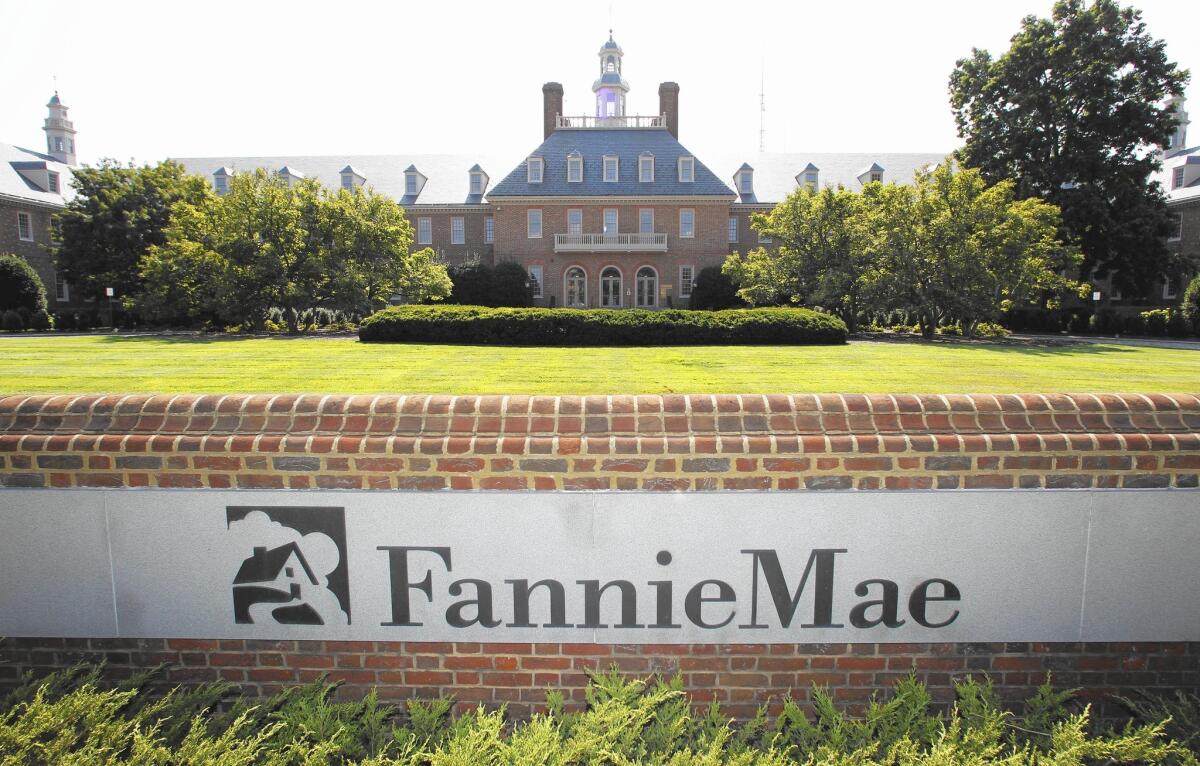Fannie Mae, Freddie Mac reach deal to ease mortgage lending

- Share via
Mortgage financing giants Fannie Mae and Freddie Mac, together with their federal regulator, have drawn up rules aimed at loosening constricted lending standards to make mortgages more affordable and easier to get for those with less than stellar credit.
The move comes in response to criticism that banks have clamped down too much on loan criteria to avoid legal liability for any mortgages they sell to Fannie or Freddie that may go bad in the future.
The two companies, seized by the government in 2008 as they teetered on financial collapse during the Great Recession, turned on lenders over mortgages that fell apart as the market melted down in 2007. Many loans were poorly underwritten, with some lenders accepting simply a borrower’s statement on income rather than verifying it.
Bankers have been forced to pay tens of billions of dollars in recent years to settle assertions that the bad loans violated representations and warranties made when the loans were sold and demanding that the banks repurchase them.
In reaction, lenders have drawn their purse strings tighter than Fannie and Freddie require when evaluating loan applications, saying the threat of repurchase demands makes the risks worth taking only for borrowers with excellent credit profiles.
The clearer guidelines are intended to convince lenders that they won’t regret lending to higher-risk but still worthy borrowers, according to people briefed on the matter, who spoke on condition of anonymity because the program won’t be announced formally until next week.
Under the new rules, the financing firms would delineate what constitutes cause for requiring banks to repurchase loans. They also would reduce the minimum down payment to 3% from 5% generally needed to qualify for selling the loans to Fannie and Freddie.
The changes resulted from discussions that trade group Mortgage Bankers Assn. arranged between lenders and Fannie, Freddie and their regulator, the Federal Housing Finance Agency.
Fannie and Freddie are the biggest pillars of support for U.S. housing, guaranteeing 59% of all mortgages being written. They are regulated by the Federal Housing Finance Agency, which has tried to address the lenders’ complaints previously with changes that produced little effect on tight standards.
An FHFA rule that took effect in January 2013 said loans on which the borrower paid as agreed for the first 36 months would not be candidates for repurchasing unless they were clearly fraudulent or seriously overstated the borrowers’ qualifications.
Earlier this year, the FHFA further loosened its rules so that loans would be deemed solid even if a borrower fell delinquent for 30 days on two separate occasions during the first 36 months.
Fannie and Freddie guidelines set a minimum credit score at 620, once widely regarded as the cutoff between prime and subprime borrowers. But this year the average loan guaranteed by Freddie has a 742 credit score, high in the “excellent” credit range and down only a little from 756 in 2012.
The reduction in the minimum down payment for most Fannie and Freddie loans to 3% brings the requirement in sync with the Federal Housing Administration, which insures loans made to first-time and lower-income borrowers.
A few Fannie and Freddie programs already offer a 3% down payment. The giant mortgage companies generally require borrowers with down payments of less than 20% to buy private mortgage insurance to offset the greater risk, and will do so under the new guidelines.
Fannie and Freddie buy mortgages and issue debt securities backed by payments on the loans. The companies guarantee to pay investors themselves if the borrowers go delinquent.
Tight lending standards have held back home purchases by average buyers in recent years, slowing the nation’s economic recovery.
The Urban Institute estimates that 1.2 million more home loans would have been made in 2012 had the lending standards common in 2001 — well before safeguards were tossed out the window during the housing bubble — been in place.
Investors paying all cash for foreclosed properties buoyed housing markets for several years, but a decline in distressed sales and rising home prices have reduced those once common transactions.
The California Assn. of Realtors last week projected that home sales in the state this year would fall nearly 65,000 short of their initial forecast, in part because of tighter mortgage lending.
At No. 1 mortgage lender Wells Fargo & Co., Chief Financial Officer John R. Shrewsberry said this week that the standoff over mortgage repurchases has created two mortgage markets, only one of which — for affluent borrowers with well-established credit — serves borrowers well.
The low- to middle-income and minority borrowers most often thwarted by the tougher lending standards are also the same people who were hit hardest in the mortgage crisis, said Paul Leonard, California director of the Center for Responsible Lending.
“Those folks took it on the chin the hardest and have been least able to get up off of the mat,” Leonard said. “That’s a serious challenge in terms of building wealth.”
“There’s a perception of a lot of risk in lending to these communities,” he said. “Understandably, after the crisis the pendulum of mortgage credit standards swung to a far extreme. It’s now working its way back to a more moderate position.”
David Stevens, president of the Mortgage Bankers Assn. and a former FHA commissioner in the Obama administration, said his group has been in talks with the White House about ways to devise clearer guidelines.
“You’ve got to give confidence to lending institutions that they’re not going to be held accountable for minor mistakes,” Stevens said. “All the incentives [for lenders] right now are not aligned around prudent judgments. They’re aligned around complete risk avoidance for fear of retribution.”
Twitter: @ScottReckard
Twitter: @bytimlogan
More to Read
Inside the business of entertainment
The Wide Shot brings you news, analysis and insights on everything from streaming wars to production — and what it all means for the future.
You may occasionally receive promotional content from the Los Angeles Times.












